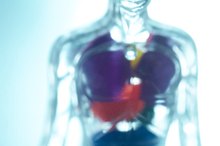What does fact checked mean?
At Healthfully, we strive to deliver objective content that is accurate and up-to-date. Our team periodically reviews articles in order to ensure content quality. The sources cited below consist of evidence from peer-reviewed journals, prominent medical organizations, academic associations, and government data.
The information contained on this site is for informational purposes only, and should not be used as a substitute for the advice of a professional health care provider. Please check with the appropriate physician regarding health questions and concerns. Although we strive to deliver accurate and up-to-date information, no guarantee to that effect is made.
How to Strain Urine for Kidney Stones
When passing a kidney stone, straining your urine allows your physician to send the stone for testing. This analysis reveals the composition of the kidney stone and enables your doctor to institute a plan to possibly prevent the formation of future stones 1. While straining the urine can be inconvenient, it is important to complete this task for diagnosis when passing a kidney stone.
Drink plenty of fluids, which can aid in the stone's passage from the kidneys to the urethra. It is important to remain hydrated and continue drinking fluids. The more fluids you ingest, the more likely the stone will pass quickly out of your system.
How Long Does It Take to Pass a Kidney Stone?
Learn More
Place a urinal in the toilet. This typically fits under the top lid of the toilet. If a urinal is not available, urinate into a clean container that allows the liquid to be easily poured through the strainer. Urinate as needed into the urinal or container in accordance with your doctor's instructions. This is typically from the first onset of kidney stone pain until passage of the stone is complete. Depending on the size and shape of the stone, this may take a few hours or as long as a few days.
Strain the urine. After each visit to the bathroom, pour the urine from the urinal or container through the strainer. The stone should be visible after the urine has been strained. If a medical strainer is not available, a coffee filter also works well. Collect any kidney stones that are left after straining 1. If the stone was crushed prior to passage, there may only be fragments of the stone to collect, but collect all the matter for testing. Your physician or lab should provide a specimen container to place the stone in for delivery to the lab facility.
Kidney Stent Side Effects
Learn More
Deliver the stone to the lab or doctor’s office for pathological testing. Results from the tests should be available in a few days and will provide the doctor with insight into the causes of the kidney stone. This new information may lead to dietary changes to help combat future stone formation.
Related Articles
References
- Mayo Clinic: Kidney Stones
- National Institute of Diabetes and Digestive and Kidney Diseases. Symptoms & Causes of Kidney Stones. Updated May 2017.
- National Institute of Diabetes and Digestive and Kidney Diseases. Definition & Facts for Kidney Stones. Updated May 2017.
- Brikowski TH, Lotan Y, Pearle MS. Climate-related increase in the prevalence of urolithiasis in the United States. Proc Natl Acad Sci U S A. 2008;105(28):9841–9846. doi:10.1073/pnas.0709652105
- National Institute of Diabetes and Digestive and Kidney Diseases. Treatment for Kidney Stones. Updated May 2017.
- National Kidney Foundation. 6 Easy Ways to Prevent Kidney Stones.
Writer Bio
Leigh Anthony has provided ghostwritten content for a variety of small-business sites since 2004. Her work appears on eHow and Chron.com. Her areas of expertise include marketing, human resources, finance and leadership. She holds a Master of Business Administration from the University of Georgia.









